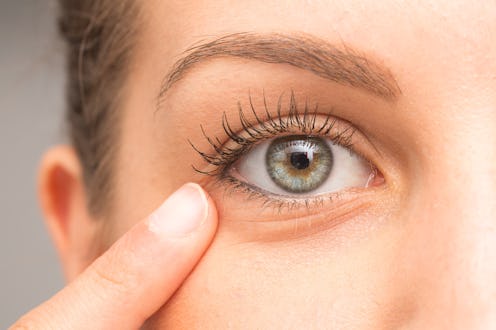Style
The Only Home Remedy For Styes You Need To Know, According To Doctors

The higher my glasses prescription got, the more sensitive my eyes became — and, it seems, the more prone to styes I became. Gone were the days I could sleep in my contacts. Buying cheap contacts that I can wear for weeks? Not an option for these old eyes; daily contacts are now the safest option for me. That being said, it's pretty hard to be a young lady/bartender that always has time to take care of your eyes. Sure, my contacts always make it out of my eyes, but there are nights I literally just pop them out of my eye and let them dry up on wherever they land. It's the very rare occasion I find myself falling asleep in my contacts, which you know means I'm sleeping with a full face of makeup too — and that means I'll probably need a home remedy for a stye when I wake up.
For those fortunate enough to not experience the pain and shame of the stye, you're seriously lucky. Most of us get at least one in our lives, and they’re caused by “inflammation and sometimes bacterial overgrowth,” according to New Jersey-based dermatologist Dr. Rebecca Baxt, MD, MBA, FAAD.
Dr. Samuel D. Pierce, O.D., President of the American Optometric Association (AOA), further explains that, “A stye is a red, swollen, and often painful bump near the root of an eyelash or close to the edge of the eyelid. Styes often look like a pimple on the eyelid and are filled with pus.” These pus-filled lumps (sorry) on the inside or outside of our eyelids are usually the result of a bacterial infection.
A stye doesn't necessarily mean you have horrible hygiene, by the way. "Patients who have blepharitis, an inflammation of the eyelids, or rosacea may also have an increased risk of developing styes,” Pierce says. If you don’t have any of those conditions, the doctors Bustle spoke to for this piece all said that the most common ways styes are triggered are if you touch your eyes a lot without washing your hands first (this includes when you’re putting contact lenses in), use expired cosmetics, or sleep with your makeup on.
Luckily, styes rarely develop into something serious. “Styes usually last for a couple of days before beginning to disappear on their own or with home care measures,” Pierce says. In rare cases, the infection that caused the stye can spread to the surrounding tissue if it's not treated, optometrist Dr. Maria Richman, O.D., FAAO tells Bustle. “This can lead to an Orbital or Preseptal Cellulitis. In any of these cases, oral or IV antibiotics may need to be prescribed,” Richman explains. “Also, by leaving a stye untreated it can form a chalazion, which is a hard lump under the eyelid surface. If that occurs, it may need to be surgically removed.”
While there are plenty of home remedies for a stye out there on the internet, Baxt, Pierce, and Richman all agree that the most effective method is to apply a warm compress to the affected area for 10 to 15 minutes up to four times per day. “When applying the warm compress, be sure to wash your hands thoroughly first and use a clean washcloth,” Pierce says. “Also, make sure the water is not hot enough to burn or scald the skin. You can remoisten the washcloth as necessary to keep it warm.” Baxt recommends following the warm compress (which helps the stye drain) with a cool compress (which can reduce inflammation). While you’re in the treatment stage, Richman says you should stop wearing contacts and eye makeup. And although it might be tempting, Richman says you should never, ever squeeze your stye.
A very important thing to remember about trying a treatment yourself with a home remedy for a stye: Since we know styes are bacterial infections, we know that we are going to want to be keeping the location clean, even when you aren’t having a compress sesh. Each time you are about to approach your stye, wash your hands first. In fact, washing your hands before you decide to rub your eyes during allergy season, get an eyelash out of your eye, or put on eye makeup is a smart idea to keep future styes away. Pierce also recommends tossing your old eye makeup, as bacteria can build up in products that are expired.
If you’ve been compressing regularly as part of your home remedy and the stye still isn’t going away , it’s time to see a doctor. “You should see your eye doctor when you experience redness, pain, or swelling of the eyelid area,” Richman elaborates. Pierce agrees, saying, ”If a stye looks worse and/or becomes more painful after 48 hours, consult with your doctor of optometry. At this point, the stye will most likely require antibiotics.”
This post was originally published in 2014. It was updated and republished on June 17, 2019. Additional reporting by Kara McGrath
This article was originally published on